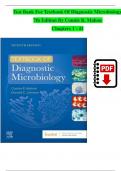Exam (elaborations)
TEST BANK For Textbook of Diagnostic Microbiology, 7th Edition By Connie R. Mahon, Verified Chapters 1 - 41, Complete Newest Version
TEST BANK For Textbook of Diagnostic Microbiology, 7th Edition By Connie R. Mahon, Verified Chapters 1 - 41, Complete Newest Version TEST BANK For Textbook of Diagnostic Microbiology, 7th Edition By Connie R. Mahon, Verified Chapters 1 - 41, Complete Newest Version Textbook Of Diagnostic Microbiol...
[Show more]




